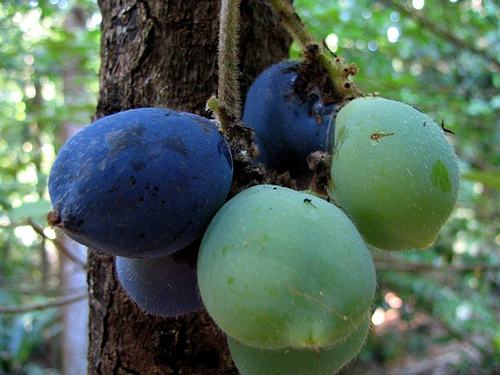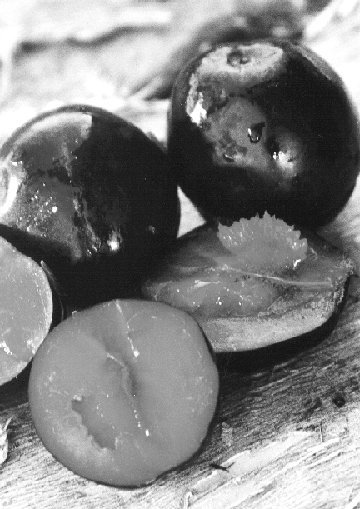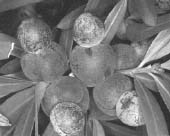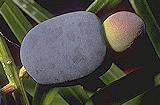| Issue 12 | |
Kidney Wallum or daal-gaal ~ John WrenchPlum Pine - Podocarpus elatus Thank you, Manson Bailey, for these Aboriginal dialect names for Podocarpus elatus. The first is from the Mooloolah district, the second from the Barron River. No marks, however, for not referring to the so-called plum (Illawarra plum Brown plum pine). Why so called? First, like so many common names, it's a nonsense. Not confined to the Illawarra area and not a plum (family Rosaceae). Not even an angiosperm and thus not even a true fruit at all. Now this is a wholesome, family magazine, so let's talk family. Podocarpus is an ancient family of gymnosperms, well established 135 million years ago, long before the Gondwana break up. The name is derived from the Greek: pous podos - afoot and carpos - a fruit. This refers to the swelling of the peduncle, the foot or stem of the cone (sometimes two) to form a fleshy receptacle resembling a true fruit, with the small cone perched at the end. The term 'gymnosperm', meaning 'to include seed', refers to the relatively unenclosed structure yielding the male and female gametes and the subsequent seeds, as compared with the more complex structure of flowers and fruits in the modern plants, angiosperms. The male and female stroboli, formed by an assembly of bracts, may be present on the same or different plants, that is, they are said to be monoecious or dioecious respectively. The gymnosperms offer reasonably easy access to the ovules by the prodigious quantities of air born pollen cells. Podocarpus happens to be dioecious, so the practical issue for growers is to ensure the pollination of female trees by adopting appropriate strategies. First, how to identify make and female plants at planting time - I certainly do not know how. The simplest remedy lies in a two-fold approach: - take a statistical view, never planting a crop of less than three trees, improving the odds with each addition - avoid straight line rows, planting in blocks to maximise pollination The spread of pollen by wind drift can be quirky, regardless of a theoretical prevailing wind direction. In Brisbane, there are several small communities of Brown pine in streets and parks which have never been seen to bear a crop, although quite mature. They must be all male or all female, with no mates in the area. On the other hand, there are a few isolated female trees which bear well, although the source of pollen is not evident, but certainly within reach. But at what distance? One hundred, two hundred metres? A kilometre? If you should read in the Courier Mail of the arrest of an elderly weirdo, caught prowling in suburban backyards, realise that I have been on a serious scientific mission to solve this problem. So much for the pollination, but don't expect it to happen for at least a decade or so after the birth of the plant. The natural (original) distribution of the Brown plum is interesting - from Nowra (SE NSW) to the Queensland border and Moreton district, the Mary River above Gympie, then north to Proserpine, then on to the Rocky River near Coen. From this distribution, it should be called 'snake berry'! Regardless of the zone, it grows on enriched creek/river margins, especially of laval origin, even on sandier soils near the coast but not on stony ridges. In practice, it will perform well in most situations with enough soil, adequate moisture, good mulching, fertilising and drainage and full sun. Early colonial records (Bailey, again) indicate its value as a versatile timber. This information may appeal to growers seeking multi purpose plants. I have inspected panels of Brown pine, revealed during demolition of an original colonial building at the Royal Brisbane Hospital. To return to bushfoods, the so called plums contain some sugar (not high) interestingly viscous colloids and a deep purple colouration. The flavour is unmistakably resinous with tannins in the skin and a slight problem with the stems through the centre. Each plum is not a fruit but a receptacle surrounding the hardened peduncle which contains the tough vascular bundles. There are other problems concerning ripeness. 'Fruit' which has fallen to the ground is fully ripe and has a better flavour than those picked, which are somewhat bitter and tannous if immature. Common sense and the food ordinances argue against ground collection, so some form of suspended catchment is indicated. This could take the form of shade cloth on frames (even old parachutes!) cleared every 24 hours. Regardless of the picking method, the next step is to detach the 10mm cones by rotation between thumb and finger. if stored under dry conditions, the cones will retain viable seeds for some years. I have achieved a strike rate of about 80% with four year old cones. A word about the colour; it is one of the reasons for the popularity of this 'plum' in commercial sauces, jams, etc. Predicably, it undergoes a dramatic change to reddish hues on admixture with acidic fruits as the pH falls, eg, in making jams. A somewhat startling experience results from pulping the raw 'plums' in a food processor - instant purple thixotropic* flummery, revealing the high content of polysaccharide colloids. Judging to its response to cooking with sugar and acid, the colloids certainly include pectinoid substances. Issue 4 of the magazine contained an article on jam making, including a simple test for pectin, reproduced from Bushfood and Walkabout teaching notes.
Since pectin is insoluble in ethanol, one part of cooked fruit liquid diluted with three parts of methylated spirit, produces, after agitation, some degree of turbidity or even clotting in three minutes, the adequacy for jam set. Advances in horticulture and agriculture depend on selection and broadening of selected strains, amongst other things. As with the Riberry and Burdekin plum, there are some obviously superior Brown pine strains, as most collectors have discovered. As far as I know, however, there is no evidence that selection and propagation of such material is occurring with this species. Frankly, the variables determined by weather, seasons, site, soil and degree of maturity at harvest make it difficult to assess superiority accurately. By comparison with Riberry, the lead time from propagation (seed or cutting) to cropping is rather protracted - over a decade. In addition, plantation production is still slight, most crops coming from wild harvest/parks and gardens. Consider some of the problems: many good trees are in reserves or National Parks. the venomous snake problem in the Mary Valley is awesome (both in numbers and size) bush sites with thick undergrowth are almost impossible to harvest, as compared to public parks with a mown ground surface. Despite these difficulties, some tonnes of these 'plums' are gathered each year along the east coast, much of it converted to foodstuffs. I look forward to the day when processing of this and other bushfoods will develop formulae less dependent on exotic materials (and titles)as the properties and usefulness of the companion bush materials (herbs and spices) become better known and better employed. * thixotropic - a sloppy substance which becomes thick on beating or stirring. |
Index 12The People of Yarrawarra Aboriginal Corp Bush Dust - The Spicy Tasmanian |
More on Davidsonia...from Kris Kupsch, 'Ooray Orchards' Pty Ltd anical name: Davidsonia sp. nov. Distribution: Confined to the remnant of the Mount Warning shield volcano, having so far been recorded in around 14 locations between Tintenbar in the South, Nimbin in the west and the Currumbin Valley in the North. Habitat Occurs in wet sclerophyll forest and, less commonly, in lowland sub-sub-tropical rainforest (less commonly here as lowland sub-sub-tropical rainforest is not common!) The smooth leafed Davidson plum often grows with Brushbox and Flooded Gums as an understory tree. The soil is often basalt derived although this species also grows naturally on the meta-sediments of the Burringbar Valley. Often occurs on previously cleared land, which assists this species development. The annual rainfall varies between populations in area of 1400mm - 2500mm pa. Of the ten locations that I've personally sighted, all but one clump occur on hillsides, due to the level, alluvial land being largely cleared of vegetation. The species occurs from approximately 20 metres to 400 metres above sea level. Tree Habit A very bush small tree to 10m, occurring in clumps originating from rhizomes along the roots. Some clumps consist of trees numbering in their hundreds. Genetic examination may prove that each clump is of the same genetic stock. Although 90% of observed specimens are in a closed canopy system, one large specimen in an open paddock was just as wide as it was high, with branches reaching back down to the ground. Some trees develop slight buttressing but only on shallow soils on steep hills. Fruit Description Fruit varies considerably between isolated genetic stock. Some fruit is smaller than that of Davidsonia pruriens jerseyana, resembling something like a large grape. Some (a few) specimens produce an abundance of moderately sized fruit, with a few whoppers thrown in to grab your attention! The colour is a little lighter than usual Davos, being a pinky purple. Shape is different also, with fruit being wider than they are long. The fruit drop from the start of December and, from reference, until the end of April, but more often till the end of February/early March. As with size, weight may vary between 30-8 grams (sometimes more). This species of tree is unique, having its own mechanism against immediate mass propagation, leaving only the dedicated enthusiasts to tackle the secrets (past and present. The story is simple - the species has become sterile and cannot produce viable seed. One theory for this is that the vector (pollinator) has become extinct and this no seed can set. So how has this species known that it wasn't producing viable seed and thus must sucker to save itself? As well -what was the time period between losing the vector and the time it began to sucker? It's all a bit confusing when only a day or so ago I saw wild bees at the flowers! In the end, nature has its way. Flowers The flowers occur both in the leaf axils at the ends of the leafy shoots (which grow at the onset of flowering) and also on the old wood towards the ends of the branches. They are pinky red, in panicles up to 15cm long. Flowers are produced between September and late December or early January. Varieties At present, there are no registered cultivars, although a couple of wild populations show considerable superiority when grown in cultivation. There is a large difference in all localities, ranging from fruit size, flowering time, leaf size, leaf shape and colour. Climatic and soil requirements These trees would do best in a sub tropical climate with adequate moisture available during fruit set (Nov-Dec). It can handle light frost. It appears to be doing very well on the Atherton Tablelands (N. Qld) although the noticeable dry season halts growth and may delay flower initiation. The amount of degree hours below 10o is unknown but may prove to be a major factor in relation to flower initiation and thus fruit yields. The soil type isn't of real importance although, due to the high demand for water during fruit set, a soil with high moisture retention could be important; a clay loam soil would be ideal provided drainage was unimpeded. The trees handle full sun provided they don't dry out and are best protected from the wind in all directions, as the limbs are brittle, especially when holding fruit. The fruit can be damaged by sunburn. I have noticed that the flowers favour growing in the shade of the leaves. Propagation Because this species doesn't produce seeds, other methods have been sought. Semi hardwood cuttings have proven relatively easy, although the roots that are produced are very fine and delicate. The cuttings can also be variable in growth and vigour. Recently, tissue culture has been introduced with success and this method should gain popularity. Marcots or air layering is also successful, forming roots within 6 weeks (during October). Root and stem cuttings may also prove successful. Planting and Spacing Care must be taken not to damage the fine roots when planting out. The trees would be ideally spaced at 4m apart or interplanted with Davidsonia jerseyana. Production Management The orchard should be free of weeds, preferably mulched, so that a sheet can be placed under the tree to collect fruit. Fruit UseThe fruit of this species would be most likely suited to wine production, as, with jam making, the seeds have a sharp point and are fiddly to remove. The yields are also excellently suited to wine production. Growth ratesA specimen in my garden has obtained a height of 3m in 4 1/2 years, without fertiliser or additional water. Time to maturityA five-year-old tree has produced 3 kg, although a twelve-year-old was known to have produced more than 40kg last season. Problems The establishment phase can be tricky, however, with adequate soil moisture and partial shade this can be overcome. Lack of propagation material is at present hampering development. Returns per acre, compared with the capital invested, in the short term are very low, though with time the trees produce more than other plums. Tree Management With cutting stock, the trees tend to become very bushy and it may be beneficial to 'tree'. This involves removing all of the lower branches, which helps with orchard maintenance. No pruning is required. Fertiliser requirements There are two sides to this question - one being organic, the other inorganic. I choose to use a mixture of the two for establishment of the orchard and intend to go fully organic after crop establishment, when maintenance isn't so high. During the early stages, it is important to supply high amounts of calcium for root growth and nitrogen for leaf growth, while not forgetting the other elements. Calcium ammonium nitrate is an effective and economic fertiliser that is high in N and Ca. Organically speaking, the addition of blood and bone or Dynamic Lifter Long Life is beneficial though not high in nitrogen. In heavy soils, gypsum is good for improved soil structure and is high in calcium. Fish emulsion is also excellent. Yields As mentioned earlier - 5 years - recorded 3 kg. 12 years - recorded 40kg Trees bear considerably more fruit after year 8. Hints The use of nitrogen fixing green manure crops planted before planting is very beneficial, improving growth markedly. Inter-row planting with a perennial legume provides protection from extremes and releases nitrogen. American Joint Vetch is ideal, clover is a good weed smotherer and pinto peanut would also do the job. (Some) Made up Names Fruiting TimesDavidsonia amplissimus April-September Davidsonia pruriens June - November (variable) Davidson jerseyana Nov-Feb Davidsonia rhiznodii Dec - Feb (poss Apr) |
|

|
|
 |
|



